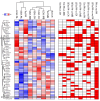Proteomic Profiling of Cerebrospinal Fluid and Its Extracellular Vesicles from Extraventricular Drainage in Pediatric Pilocytic Astrocytoma, towards Precision Oncology
- PMID: 38539556
- PMCID: PMC10969024
- DOI: 10.3390/cancers16061223
Proteomic Profiling of Cerebrospinal Fluid and Its Extracellular Vesicles from Extraventricular Drainage in Pediatric Pilocytic Astrocytoma, towards Precision Oncology
Abstract
Pediatric pilocytic astrocytoma (PA) is the most common brain tumor in children. Complete resection provides a favorable prognosis, except for unresectable PA forms. There is an incomplete understanding of the molecular and cellular pathogenesis of PA. Potential biomarkers for PA patients, especially the non-BRAF-mutated ones are needed. Cerebrospinal fluid (CSF) is a valuable source of brain tumor biomarkers. Extracellular vesicles (EVs), circulating in CSF, express valuable disease targets. These can be isolated from CSF from waste extraventricular drainage (EVD). We analyzed the proteome of EVD CSF from PA, congenital hydrocephalus (CH, non-tumor control), or medulloblastoma (MB, unrelated tumoral control) patients. A total of 3072 proteins were identified, 47.1%, 65.6%, and 86.2% of which were expressed in the unprocessed total and in its large-EV (LEV), and small-EV (SEV) fractions. Bioinformatics identified 50 statistically significant proteins in the comparison between PA and HC, and PA and MB patients, in the same fractions. Kinase enrichment analysis predicted five enriched kinases involved in signaling. Among these, only Cyclin-dependent kinase 2 (CDK2) kinase was overexpressed in PA samples. PLS-DA highlighted the inactive carboxypeptidase-like protein X2 (CPXM2) and aquaporin-4 (AQP4) as statistically significant in all the comparisons, with CPXM2 being overexpressed (validated by ELISA and Western blot) and AQP4 downregulated in PA. These proteins were considered the most promising potential biomarkers for discriminating among pilocytic astrocytoma and unrelated tumoral (MB) or non-tumoral conditions in all the fractions examined, and are proposed to be prospectively validated in the plasma for translational medicine applications.
Keywords: cerebrospinal fluid; extracellular vesicles; extraventricular drainage; large extracellular vesicles; pilocytic astrocytoma; proteomics; small extracellular vesicles.
Conflict of interest statement
The authors declare no conflicts of interest.
Figures




Similar articles
-
Identification of Central Nervous System Oncologic Disease Biomarkers in EVs from Cerebrospinal Fluid (CSF) of Pediatric Patients: A Pilot Neuro-Proteomic Study.Biomolecules. 2023 Nov 30;13(12):1730. doi: 10.3390/biom13121730. Biomolecules. 2023. PMID: 38136601 Free PMC article.
-
Proteomic analysis of cerebrospinal fluid extracellular vesicles: a comprehensive dataset.J Proteomics. 2014 Jun 25;106:191-204. doi: 10.1016/j.jprot.2014.04.028. Epub 2014 Apr 24. J Proteomics. 2014. PMID: 24769233
-
Potential biomarkers of childhood brain tumor identified by proteomics of cerebrospinal fluid from extraventricular drainage (EVD).Sci Rep. 2021 Jan 19;11(1):1818. doi: 10.1038/s41598-020-80647-w. Sci Rep. 2021. PMID: 33469081 Free PMC article.
-
Adult pilocytic astrocytoma in the molecular era: a comprehensive review.CNS Oncol. 2021 Mar 1;10(1):CNS68. doi: 10.2217/cns-2020-0027. Epub 2021 Jan 15. CNS Oncol. 2021. PMID: 33448230 Free PMC article. Review.
-
Reimagining pilocytic astrocytomas in the context of pediatric low-grade gliomas.Neuro Oncol. 2021 Oct 1;23(10):1634-1646. doi: 10.1093/neuonc/noab138. Neuro Oncol. 2021. PMID: 34131743 Free PMC article. Review.
Cited by
-
Deep Proteome Analysis of Cerebrospinal Fluid from Pediatric Patients with Central Nervous System Cancer.J Proteome Res. 2024 Nov 1;23(11):5048-5063. doi: 10.1021/acs.jproteome.4c00471. Epub 2024 Oct 9. J Proteome Res. 2024. PMID: 39382389 Free PMC article.
References
Grants and funding
LinkOut - more resources
Full Text Sources
Research Materials
Miscellaneous

